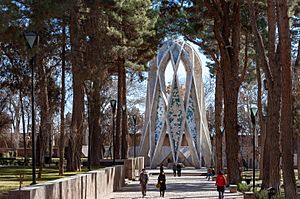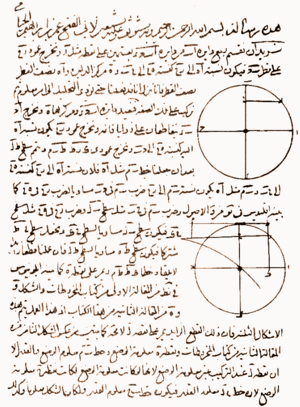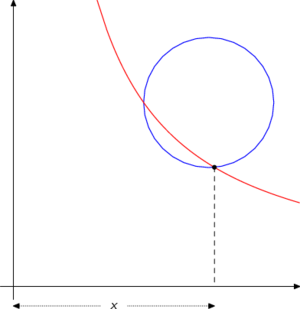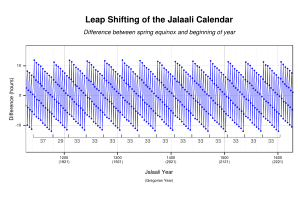Omar Khayyam facts for kids
Quick facts for kids
Hakim
Omar Khayyam
عمر خیّام |
|
|---|---|

Statue of Omar Khayyam by Abolhassan Sadighi
|
|
| Born | 18 May 1048 |
| Died | 4 December 1131 (aged 83) Nishapur, Khorasan, Seljuk Empire
|
| Academic background | |
| Influences | Avicenna, al-Khwārizmī, Euclid, Apollonius of Perge |
| Academic work | |
| Main interests | Mathematics (medieval Islamic), astronomy, Persian philosophy, Persian poetry |
| Influenced | Tusi, Al-Khazini, Nizami Aruzi of Samarcand, Hafez, Sadegh Hedayat, André Gide, John Wallis, Saccheri, Edward FitzGerald, Maurice Bouchor, Henri Cazalis, Jean Chapelain, Amin Maalouf |
Omar Khayyam (born May 18, 1048 – died December 4, 1131) was a super smart person from Persia. He was known as a polymath, which means he was an expert in many different fields. He made big contributions to mathematics, astronomy, philosophy, and Persian poetry.
Omar Khayyam was born in Nishapur, which was an important city in the Seljuk Empire. He lived during the time of the Seljuk dynasty and the First Crusade.
As a mathematician, he was famous for solving cubic equations. These are equations with a variable raised to the power of three (like x³). He found ways to solve them using shapes like cones. Khayyam also helped us understand the parallel axiom, which is a basic rule in geometry about parallel lines.
As an astronomer, he figured out how long a year is with amazing accuracy. He also created the Jalali calendar. This calendar is a solar calendar, meaning it's based on the sun's movement. It was so good that it's still the basis for the Persian calendar used today, almost a thousand years later!
Many people also know Omar Khayyam for his poetry. He wrote short poems called quatrains (rubāʿiyāt). These poems became very popular in the English-speaking world thanks to a translation by Edward FitzGerald in 1859.
Contents
Life Story of Omar Khayyam
Omar Khayyam was born in Nishapur in 1048. His family was from the Khorasan region of Persia. In old Persian writings, he was simply called Omar Khayyam. Some people believe his family made tents, because "Khayyam" means "tent-maker" in Arabic.
Historians used details about his birth to figure out his exact birthday: May 18, 1048.
Omar grew up in Nishapur, a big city in the Seljuk Empire. It was also a major center for the Zoroastrian religion. His full name was Abu’l Fath Omar ibn Ibrahim al-Khayyam. His teachers saw how smart he was. They sent him to study with Imam Muwaffaq Nishaburi, a famous teacher who taught children of important families. Omar became good friends with him.
Around 1068, Omar traveled to Bukhara to visit its famous library. Then, in 1070, he moved to Samarkand. There, he began writing his important book on algebra. The city's governor, Abu Tahir Abd al-Rahman ibn ʿAlaq, supported his work. The ruler of Samarkand, Shams al-Mulk Nasr, treated Omar with great respect.
In 1074–5, Omar Khayyam started working for Sultan Malik-Shah I. The Sultan's chief advisor, Nizam al-Mulk, invited him to the city of Marv. Khayyam was then asked to build an observatory in Isfahan. He led a team of scientists to make careful observations of the stars. Their goal was to improve the Persian calendar.
This project started in 1076 and finished in 1079. Omar Khayyam and his team measured the length of the year very precisely. They found it was 365.24219858156 days long. This was incredibly accurate! For comparison, today the year is 365.242190 days long.
After Sultan Malik-Shah died in 1092, Omar lost his special position at court. He then went on a pilgrimage to Mecca. Some say he did this to show his faith and stop people from accusing him of not being religious enough. Later, he was invited by the new Sultan Sanjar to work in Marv. He was allowed to return to Nishapur because his health was getting worse. After that, he lived a quiet life.
Omar Khayyam died in his hometown of Nishapur on December 4, 1131, when he was 83 years old. He is buried in the Mausoleum of Omar Khayyam. One of his students, Nizami Aruzi, said that Khayyam once predicted where he would be buried. He said his tomb would be in a place where the north wind would scatter roses over it. Four years after Omar's death, Aruzi found his tomb exactly as he had described. It was at the foot of a garden wall, covered by flowers from pear and peach trees.
Omar Khayyam's Contributions to Mathematics
Omar Khayyam was very famous as a mathematician during his lifetime. Some of his math books that still exist include:
- A commentary on the difficulties concerning the postulates of Euclid's Elements (finished in 1077).
- On the division of a quadrant of a circle (written before his algebra book).
- On proofs for problems concerning Algebra (likely finished in 1079).
He also wrote a book about the binomial theorem and finding the nth root of numbers, but this book is now lost.
Understanding Parallel Lines
Khayyam's book on Euclid's Elements talked about the parallel axiom. This is a rule in geometry that says if you have a line and a point not on that line, you can draw only one line through the point that is parallel to the first line.
Khayyam was the first to look at different possibilities for this rule. He showed that if you assume the rule is true, it leads to Euclidean geometry (the geometry we usually learn). But he also explored what would happen if the rule was slightly different. His work helped show that other types of geometry, called non-Euclidean geometries, were possible. This was a very important step in math history!
Later, a mathematician named John Wallis translated some of Khayyam's ideas into Latin. Another mathematician, Giovanni Girolamo Saccheri, used Khayyam's work to develop the first ideas of non-Euclidean geometry.
Understanding Real Numbers
Khayyam's book on Euclid also helped us understand ratios and numbers better. He looked at the idea of irrational numbers, which are numbers that cannot be written as a simple fraction (like pi). He helped connect these numbers to other types of numbers.
Historians say that Khayyam started a "true revolution" in how we think about numbers. He was "on the road to that extension of the number concept which leads to the notion of the real number." Real numbers include all the numbers you can think of, like whole numbers, fractions, and irrational numbers.
Solving Equations with Geometry
Some experts believe Khayyam was a very early pioneer of analytic geometry. This is a type of math that uses algebra to solve geometry problems and vice versa. He used algebra to solve problems about dividing a circle, which led to equations with cubic (power of 3) and quadratic (power of 2) terms.
Solving Cubic Equations
Khayyam was likely the first to create a general way to solve cubic equations. He was also the first to solve every type of cubic equation using geometry, especially for positive answers. His book on algebra explains this work.
He listed all the possible types of equations involving lines, squares, and cubes. He showed how to solve simpler equations using basic geometry. For the more complex cubic equations, he used shapes called conic sections (like parabolas and circles) to find the answers. He found the positive answer by looking at where two of these shapes crossed each other.
Khayyam knew that he had solved these problems using geometry, but he also knew that finding a purely arithmetic (number-based) solution was still a challenge. He wrote that "possibly someone else will come to know it after us." It took until the 1500s for mathematicians in Italy to find the general algebraic solution for cubic equations.
Khayyam's work was a big step in connecting algebra and geometry. He was praised for his "power of generalization and his rigorously systematic procedure."
Binomial Theorem and Roots
In his algebra book, Khayyam mentioned another book he wrote. This lost book was about finding the  th root of numbers. This means finding the number that, when multiplied by itself
th root of numbers. This means finding the number that, when multiplied by itself  times, gives the original number (like finding the cube root or fourth root).
times, gives the original number (like finding the cube root or fourth root).
To do this, historians believe Omar Khayyam must have known the formula for expanding  . This formula is called the binomial theorem. An earlier mathematician had already found a way to arrange the numbers in this expansion in a triangle shape. Khayyam helped make this "triangular array" popular in Iran. Today, it is known as Omar Khayyam's triangle, but in Europe, it's called Pascal's triangle.
. This formula is called the binomial theorem. An earlier mathematician had already found a way to arrange the numbers in this expansion in a triangle shape. Khayyam helped make this "triangular array" popular in Iran. Today, it is known as Omar Khayyam's triangle, but in Europe, it's called Pascal's triangle.
Omar Khayyam's Work in Astronomy
In 1074–5, Sultan Malik-Shah asked Omar Khayyam to build an observatory in Isfahan. He also asked him to improve the Persian calendar. Omar led a team of eight scholars. They made many observations of the sky to update the astronomical tables.
They made sure the first day of the year, called Nowrūz (the start of spring), happened exactly when the sun crossed the vernal equinox. This is when the sun enters the first part of the Aries constellation before noon.
The new calendar was named the Jalālī calendar after Malik-Shah. It started on March 15, 1079. The observatory itself was no longer used after Malik-Shah died in 1092.
The Jalālī calendar was a true solar calendar. This means the length of each month matched how long the sun stayed in each Zodiac sign. The calendar used a special 33-year intercalation cycle. This means it had 25 normal years (365 days) and 8 leap years (366 days).
This calendar was used across Greater Iran for centuries. In 1911, it became the official calendar of Qajar Iran. In 1925, it was simplified and updated to become the modern Iranian calendar.
The Jalali calendar is very accurate. It only gains one day of error every 5,000 years. This makes it even more accurate than the Gregorian calendar (which gains one day every 3,330 years). Some historians consider it the most perfect calendar ever made.
One of Omar's students, Nizami Aruzi of Samarcand, said that Khayyam didn't really believe in astrology or telling the future. He said he never saw any great scientists who truly believed in it. When Khayyam worked for Sultan Sanjar, he was asked to predict the weather. He apparently wasn't very good at it! Historians explain that the old Arabic term for "science of the stars" included both astronomy (studying stars scientifically) and astrology (predicting the future from stars). Khayyam was focused on the scientific part.
Other Interesting Works
Omar Khayyam also wrote a short book about Archimedes' principle. This principle helps you figure out how much gold and silver are in a mixed object. He described a way to measure the exact weight of each metal by weighing the object in both air and water. This method was considered very accurate and smart.
He also wrote a short book about music theory. In it, he talked about how music and math are connected. Khayyam helped classify musical scales and explained the mathematical relationships between different notes.
Omar Khayyam's Poetry
The first mention of Omar Khayyam's poetry comes from a historian named Imad ad-Din al-Isfahani, who lived at the same time as Khayyam. He said Khayyam was both a poet and a scientist. Some of Khayyam's poems were quoted by other writers soon after his death.
An old manuscript from 1460, kept in the Bodleian Library, contains 158 of his quatrains. However, it's hard to know for sure which poems were actually written by Omar Khayyam. Some scholars believe that many poems were later attributed to him, even if he didn't write them.
Edward Granville Browne (1906) noted that "while it is certain that Khayyam wrote many quatrains, it is hardly possible, save in a few exceptional cases, to assert positively that he wrote any of those ascribed to him."
Besides Persian poems, there are also 25 Arabic poems that are said to be by Khayyam. Other Persian scholars also wrote quatrains, like Avicenna. It's possible that writing poetry was a hobby for Khayyam, something he did for fun in his free time.
Omar Khayyam became very famous in modern times because of the English translation of his poems by Edward FitzGerald in 1859. FitzGerald's Rubaiyat of Omar Khayyam was incredibly popular. By 1929, there were over 300 different editions of the book!
Omar Khayyam's Philosophy
Omar Khayyam saw himself as a student of Avicenna, another great scholar. He wrote six philosophical papers. One, called On existence, was in Persian and talked about what it means to exist. Another, in Arabic, discussed free will and determinism (whether our choices are truly free or already decided).
His Religious Views
When you read Omar Khayyam's poems, some people think he sounds a bit sad, or like he doesn't believe in much. They see him as someone who might have been a pessimist or agnostic. This means he might have doubted some religious ideas.
However, other people believe his poems are actually Sufi poetry, which is a type of mystical religious writing. Edward FitzGerald, who translated his poems, thought Khayyam was a religious skeptic. He said Khayyam "was hated and dreaded by the Sufis."
Some historians say that Omar's poems seemed Sufi on the outside, but might have had an anti-religious message. They also mention that he was once accused of not being religious enough. So, he went on a pilgrimage to prove his faith. After returning home, he reportedly lived a very religious life, going to worship every day.
However, other experts disagree. They say there's no strong proof that Omar Khayyam was formally a Sufi. Some Sufi mystics from his time actually disliked him, calling him an "unhappy philosopher, atheist, and materialist."
On the other hand, some scholars point to Khayyam's other writings, which are more formal and philosophical. In these, he expresses traditional religious views, praising God and Muhammad. His biographers often called him by religious titles like "Imam" (leader) and "The Evidence of Truth."
Because of all these different ideas, it's still a bit of a mystery exactly what Omar Khayyam's personal religious beliefs were. People have very different opinions about him!
Images for kids
-
"A Ruby kindles in the vine", illustration for FitzGerald's Rubaiyat of Omar Khayyam by Adelaide Hanscom Leeson (c. 1905).
-
The statue of Khayyam in United Nations Office in Vienna as a part of Persian Scholars Pavilion donated by Iran.
-
A statue of Omar Khayyam in Laleh Park of Tehran. Made by Abolhassan Sadighi.
-
Statue of Omar Khayyam in Bucharest.
-
Monument to Omar Khayyam in Ciudad Universitaria of Madrid.
See also
 In Spanish: Omar Jayam para niños
In Spanish: Omar Jayam para niños
- The Keeper: The Legend of Omar Khayyam
- Nozhat al-Majales
- Omar Khayyam (film)
- Noted Khayyamologists:
- Badiozzaman Forouzanfar
- Abdolhossein Zarrinkoob














